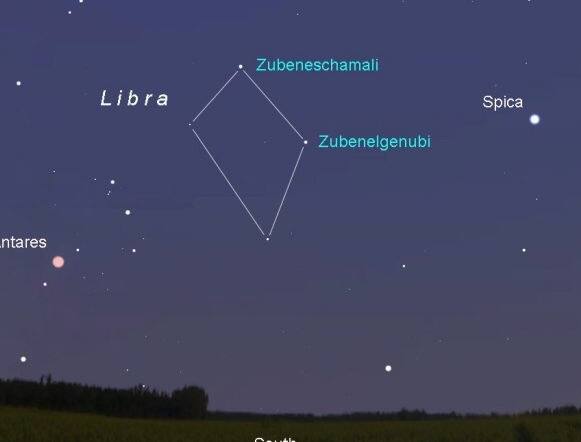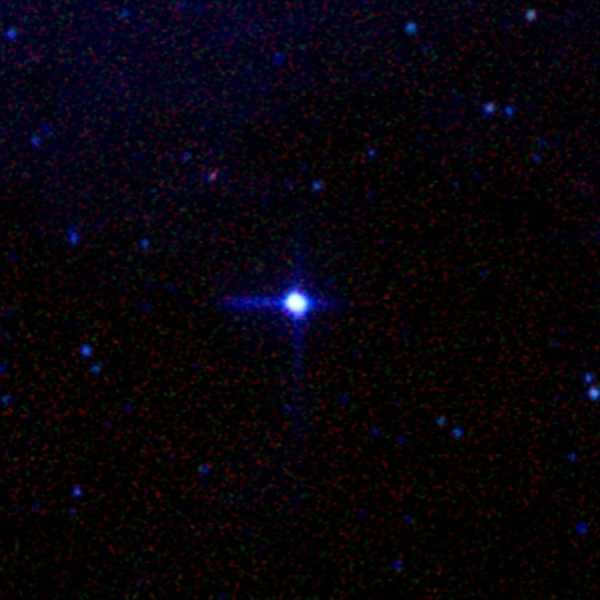
Stellar Bodies
Alpha Centauri is a triple luminous star located in the Centauri constellation. It is the nearest star system to our Solar System, at a distance of 4.37 light years. This star system is the most prominent within its stellar group and holds the third position in terms of brightness across the celestial sphere. With a visual magnitude of -0.27m, it emits a significant amount of light. The two main components of this star system are not visible to the naked eye and require the use of specialized binoculars or a telescope. Additionally, there is a third component, a red dwarf, located 2.2 degrees southwest of the main star system.
Distance
Alpha Centauri is located 4.37 light-years away from our Solar System. In the year 1977, two spacecraft called Voyager 1 and Voyager 2 were launched from Earth. If they had been aimed in the direction of Alpha Centauri, the estimated duration of such a “space journey” would have been tens of thousands of years. The distance to a star from our planet was initially calculated in 1832 using a special parallax technique. The scientists who made this calculation did not publish their findings until 1839, as the distance they determined was considered to be incredibly vast. However, in 1838, Friedrich Bessel recalculated this distance and decided to share the revised results.
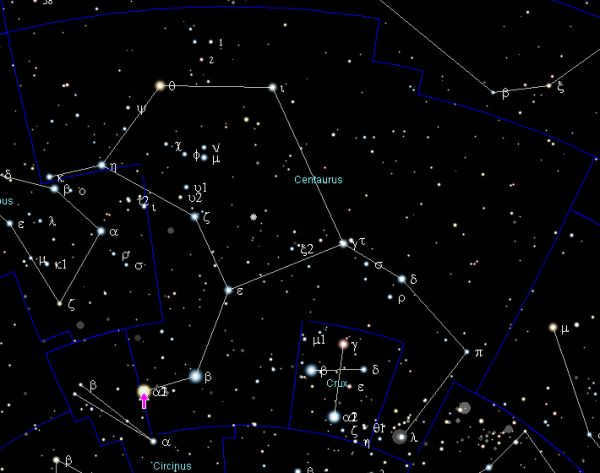

The position of α Centauri is indicated by an arrow.
Furthermore, it has been observed that the characteristics of Alpha Centauri demonstrate a significant degree of its own motion. Subsequently, it has been determined that the displacement amounts to 6.1 minutes (angular) per 100 years, which equates to a parameter of 61.3 minutes per millennium. Taking into consideration the current displacement of the object, it can be inferred that by 2970 it will draw closer to us by 3.26 years, and its maximum visual magnitude will be -0.86 units.
The universe of celestial bodies
There is a belief that within the Alpha Centauri star system, there exists a celestial entity resembling a planet. Due to its proximity to Earth, scientists have long been engaged in endeavors to locate it. The initial breakthrough came in 2012 in Geneva, after three years of extensive research. The findings revealed that this celestial body lies outside the region inhabited by the star itself.
The celestial body discovered by experts was given a nearly identical name – Alpha Centauri B b, which indicates the approximate orbit of this exoplanet. In terms of mass, it is 13% larger than Earth, and the surface temperature reaches a scorching 1200 degrees. As a result, the likelihood of life originating and existing on this entity is nonexistent. The planet is located 6 million kilometers away from its host star, and it completes one orbit every 3.236 days.
Attention! Recent scientific data indicates that this exoplanet is non-existent. In October 2015, British astronomers reevaluated the scientific data and determined that this celestial object does not exist. However, research is ongoing, and it is uncertain what conclusions scientists will ultimately reach.

Click on the image to enlarge
Other potential planets
Hypothetical celestial bodies could have independent rotations around objects A and B, or large orbital paths around the entire AB system. Both objects resemble the Sun, making the search for similar bodies particularly intriguing to astronomers. Through computational modeling, the possibility of a planet within a radius of 1.1 astronomical units has been demonstrated. Meanwhile, bodies belonging to group A are capable of orbiting at greater distances compared to objects of group B. This is attributed to higher gravitational forces.
In 2013 and 2014, a scientific study was carried out, which revealed that the star B likely possesses a planet with an orbital period of less than 20.4 days. A hypothesis was put forward in 2012 about the existence of a habitable zone. In 2019, a new phase of research commenced to explore similar regions around both A and B stars. This research is being conducted in Chile, utilizing a highly advanced telescope.
Alpha Centauri A
Alpha Centauri A, also known as Centaurus A, is a star with a mass 10% greater than the Sun and a brightness value of 51.9%. It takes 22 days to complete one revolution around its stellar axis. In terms of luminosity, this star ranks fourth in the entire sky, with an apparent magnitude of 0.01 and an absolute magnitude of 4.38.
Centaurus B
Alpha Centauri B, a star in the Centaurus constellation, has a mass that is 90% smaller than the Sun. It is also much dimmer, with a brightness that is only 44.5% of the Sun’s. However, despite its smaller size and brightness, Alpha Centauri B emits a high level of energy in the X-ray spectrum. This star is classified as a main sequence star and takes 41 days to complete one rotation on its axis. It has an apparent magnitude of 1.33 and an absolute magnitude of 5.71.
Centauri C
Alpha Centauri C is a red dwarf star that is the nearest individual object to us, with a distance of 4.24 light-years. It is situated within the corresponding constellation. When observed through the Hubble telescope, it displays a significant level of brightness, although locating it without specialized instruments can be challenging. The average level of luminosity is exceptionally low, being eight times less than that of the Sun. However, the luminosity is currently on the rise due to convection processes.
There is a fascinating proposal stating that Alpha Centauri C is closely gravitationally connected to the AB system of the same name. The distance between them is a mere 0.24 light years. Because of its very low brightness, it can only be observed with the help of a telescope. It has an absolute magnitude of 15.53 units, and it takes between 100,000 and 500,000 years to complete one orbit around AB.

Characteristics of the components of the α Centauri system
Interesting facts
The star Alpha Centauri was initially detected by European scientists in 1592. The individual responsible for this groundbreaking discovery was Robert Hughes. On the other hand, the Chinese firmly believe that it is the second star directly associated with the Southern Gate constellation (due to the asterism). Australians, conversely, hold onto the legend that this celestial body represents one of the brothers who slew Emu. It is worth mentioning that observations of Alpha Centauri can only be made from latitudes south of the equator, hence why there are no tales about it in Greek or Roman mythology.
Despite this, Alpha Centauri is a popular element in science fiction – appearing in well-known works that have become iconic. Examples include Star Trek, Guardians of the Galaxy, The Imposter, and more. In terms of its appearance, the star is quite luminous and shines in a vibrant yellow hue. Its binary nature was first discovered by an Indian researcher, and ongoing studies are still being conducted.
An average observer situated on the Alpha Centauri star system would observe the night sky without the presence of Earth. The Sun would appear as a distant star at a distance of 0.5 units, positioned towards the Cassiopeia constellation. Sirius, on the other hand, would be in close proximity to Betelgeuse. A star chart or a high-quality telescope can be utilized to study the unique characteristics of this celestial object.
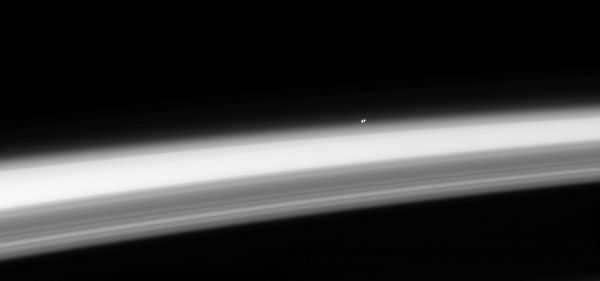
Saturn’s horizon is graced by the presence of the nearest star system, Alpha Centauri, which consists of three stars. In this captivating image, both α Centauri A and α Centauri B, which bear a striking resemblance to our own star, are clearly visible. Unfortunately, the third star in the Alpha Centauri system, the red dwarf Proxima Centauri, cannot be seen from this perspective.
The immense distance that separates us from Alpha Centauri is illustrated by the fact that it takes more than four years for light from these stars to reach our solar system.
This breathtaking image was captured by the Cassini spacecraft camera on May 17, 2008.
Physical characteristics and orbital movement
Each of the properties of the Alpha Centauri brightness possesses its own distinct characteristics:
- It is a member of the constellation with the same name;
- It is located at a distance of 4.366 light years;
- Its orbital period is 79.91 years;
- It has alternative names such as TOLIMAN, FK5 538, GC19728, etc.
As for object A, it is defined by the following fundamental parameters:
- The coordinates are as follows: 14 hours 39 minutes 36.5 seconds – right ascension;
- -60 degrees 50 minutes 2.308 seconds – declination angle;
- The visual magnitude is 0.01 units, while the absolute magnitude is 4.38;
- It belongs to the G2V spectral class;
- Its mass is 1.1 times greater than that of the Sun;
- The radius is 1.227 times larger.
- The factor of 1.519 determines its luminosity.
- The temperature is 5,790 K.
When it comes to subject B, we can discuss the following significant parameters:
- The coordinates for the time of direct ascent are 14 hours 39 minutes 35.0803 seconds.
- The declination is 60 degrees 50 minutes 13.761 seconds.
- The visual value is 1.33 units.
- The absolute parameter is 5.71.
- The cosmic body belongs to the spectral class K1V.
- The mass index is lower than that of the Sun (0.907).
- The radius is 0.865 units.
- The luminosity level is 0.5.
- The surface temperature is high, reaching 5,260 K.
Despite the fact that a significant amount of data has already been gathered, the scientific community remains intrigued by the Alpha Centauri constellation.
Space Travel Beyond Our Solar System
There is a theory that this particular celestial body will serve as the primary destination for future interstellar voyages. However, given the current limitations of our technological advancements, it is currently unfeasible to overcome the vast distance between our Sun and this star. Nonetheless, it is anticipated that such a journey will be feasible within a few decades.
Consequently, the Alpha Centauri constellation remains a subject of extensive research and observation. The ongoing efforts to explore this celestial body will continue in the coming years.
The fascinating Alpha Centauri is within our reach for examination and examination purposes. By drawing a direct line from Ursa Major to Virgo, and then descending 50 degrees below the celestial equator, we will come across the constellation we are seeking. This constellation is comprised of three stars, namely A, B, and C. Experts in the field of science assert that astronomy predates the formation of our solar system by a staggering 6 billion years. Now, let us delve deeper into this captivating subject.
The fascinating neighbors of Alpha Centauri
It is quite challenging to differentiate between the Alpha and Beta constellations with the unaided eye. However, this remarkable duo emanates an extraordinary luminosity. By simply peering through a regular telescope, the minimal gap between the celestial bodies becomes distinctly discernible. The luminous radiation emitted by these two stars takes slightly over four years to reach our planet Earth.
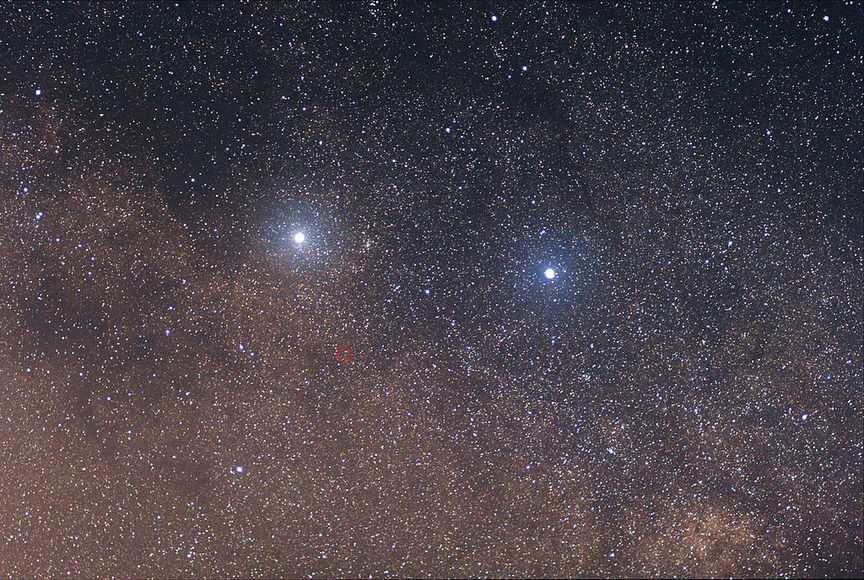
A – Rigel Centaurus
Alpha Centauri A is a star that is larger and brighter than the Sun. It emits more heat as well. It appears to overshadow Beta Centauri, but without such a remarkable companion, Beta Centauri would likely go unnoticed.
The star is also known by its Greek name, Centauri’s foot, which ancient astronomers used to identify its location. Astrologers have given it a third name – Toliman. In terms of color, the star appears white and yellow.
Beta is of lesser size compared to the sun. Positioned approximately 23 astronomical units away from Alpha, both members of the constellation are interconnected despite their contrasting characteristics. Their gravitational attraction plays a significant role in the formation of planets and other surrounding processes.
Beta orbits around Alpha in an elliptical path. It completes one revolution in 80 years, which is considered relatively quick on a cosmic scale. Alpha Centauri, also known as Hadar (bottom) and Agena (knee), has a distinct orange hue.
C is the third Proxima
The celestial body in question is the third closest object to the star system. While it cannot be seen with the naked eye, it is considered the closest celestial body to Earth. Proxima orbits around the stars Alpha and Beta, although the exact duration of this process is still unknown. Some sources suggest that it takes around 500 thousand years, while others claim that it may exceed a million years.
Due to the low temperature of Proxima, it does not emit enough heat to warm any nearby planets, making them invisible. Scientists classify Proxima as a red dwarf due to its rare, yet powerful flares. These flares are capable of emitting X-ray radiation that is 10 times stronger than solar radiation. The cause of this phenomenon remains a mystery to astrophysicists.
Interesting Facts about the Alpha Centauri System
The star system known as Alpha Centauri was first observed in 1952 by a relatively unknown English scientist. However, its binary nature was not recognized until 1689, when Jesuit priest Jean Richaud, while observing the sky in India, accidentally witnessed the passing of a comet. On the other hand, Proxima, a star in the Alpha Centauri system, was not discovered until 1915.
Situated in the southern part of the celestial dome, the Alpha Centauri system is not visible beyond 29 degrees north latitude. Where can one observe this constellation? In the United States, it can be seen near Houston and Orlando, as well as from the Florida Keys. Additionally, it can be observed year-round from the Southern Cross.
The trio of stars being considered is part of Centauri astronomy. In ancient times, the wise centaur in the sky was observed by the Greeks during the time of Jason and Hercules. According to myths, the centaur was mistakenly killed by Heracles, and Zeus immortalized him by sending him to the stars. Alpha Centauri specifically represents the right front hoof of the creature.
However, it’s not just the Greeks who have intriguing stories surrounding Alpha Centauri. The Egyptians also made use of this celestial luminary. Many temples were constructed in alignment with the point on the horizon where the star rises. In China, Alpha Centauri was referred to as the second star of the Southern Gate. The Australian Aborigines named it Bermbermgle, in reference to the two heroic brothers who defeated the Emu.
Is Life Possible on Alpha Centauri?
In 2012, the exoplanet Proxima Centauri b was discovered using the radial velocity technique. This planet, located 4.25 light years away, is the closest one ever found outside our solar system. Scientists believe that there may be liquid water on Proxima Centauri b, making its surface potentially habitable.
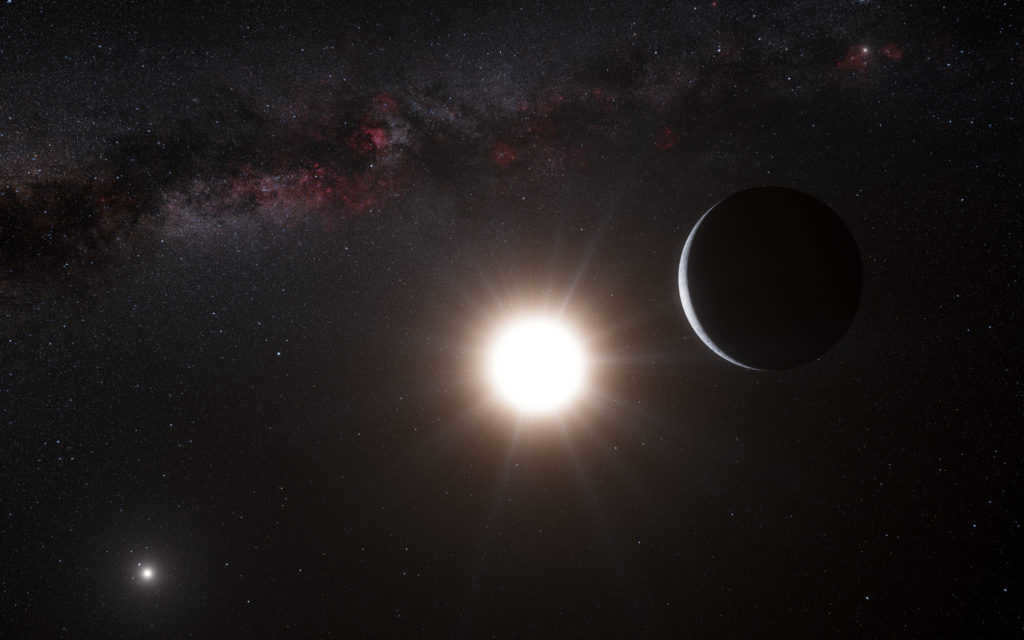
With a weight slightly higher than that of Earth, an acceptable rotational speed, and a revolution completed in 3 thousand days, the only drawback of the Alpha Centauri system is its inhospitable temperature for human life. The existence of other planets orbiting around Alpha Centauri remains unknown. However, scientists theorize that there could be Earth-like analogs in its orbit, which has led to active research in this field.
Exploring the Realm of Fiction: Interactions with Alpha Centauri’s Inhabitants
Occasionally, there are accounts of such encounters shared by individuals who possess the ability to venture into the ethereal realm. Through the power of telepathy, they establish connections with “space emissaries” and are able to articulate the enigmatic phenomena of the cosmos that lie beyond our comprehension.

Contactors report that occasionally extraterrestrial beings come to Earth and provide scientists with clues for discoveries. These creatures are amicable and pose no harm to the inhabitants of our planet. On occasion, they even take some individuals as “tourists” to their realm to demonstrate what we should aspire to achieve. After all, the race from Alpha Centauri is considerably more advanced than us. Furthermore, these higher intelligence beings are willing to share their accomplishments, on the condition that we apply the knowledge for the greater good.
A journey to Alpha Centauri
According to scientific calculations, it would require over a millennium to embark on a voyage to the constellation using the most advanced spacecraft currently available. Up until now, this feat is still considered unattainable for humanity.

However, a group of NASA researchers led by Harold White is currently engaged in Project Velocity, a groundbreaking endeavor that is being funded by Stephen Hawking and other benefactors. The main objective of the project is to develop an extraordinary engine capable of surpassing the speed of light, thereby enabling interstellar travel to the nearby star system Alpha Centauri within a matter of weeks.
The ambitious plan involves constructing a fleet of nanoships, with the collaborative efforts of daring experimentalists and astrophysicists. This remarkable feat is anticipated to be realized in approximately 200 years.
Spy satellites are currently being developed individually. In a few decades, miniature devices resembling postage stamps will have the capability to reach the stellar system. It is anticipated that within four years, humanity will receive photographs and data that will be sufficient to organize a genuine expedition.
Nevertheless, these facts regarding the challenges of exploring uncharted regions of the Galaxy do not hinder our ability to indulge in fantasies. The Alpha Centauri system bears resemblance to our own solar system, which many authors and screenwriters capitalize on in their works. We have the opportunity to immerse ourselves in books or videos that depict a bustling life in the field of astronomy, the construction of spaceships, and encounters with friendly extraterrestrial beings. Furthermore, we can even purchase an apartment in the “Alpha Centauri” residential complex and envision a future where the vast expanse of space has already been conquered…
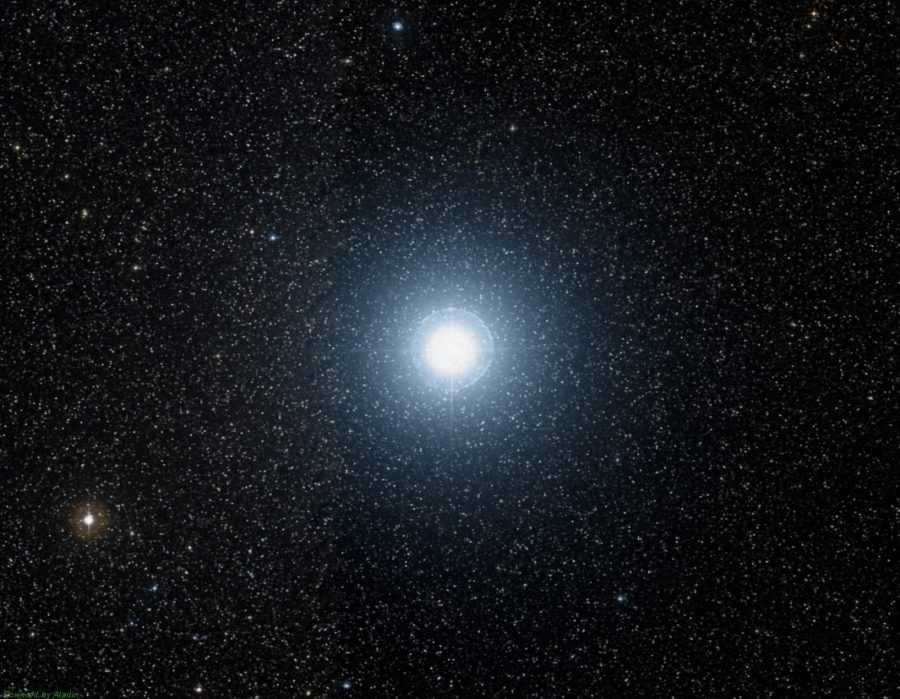
The bird of prey was observed by both the Sumerians and Babylonians. The aborigines of Australia and the Indians of Canada also made similar connections. The Chinese depicted it as the “Second Star of the Drum at the River,” while the people of Micronesia referred to it as “Big Bread” and the Maori called it the “Celestial Pillar.” However, the Arabs named this shining celestial body Altair, which translates to “flying eagle.”
A mysterious extraterrestrial being.
Scientists are unable to approach Altair closely as the capabilities of modern equipment are insufficient to fully study its properties and characteristics. If an individual’s horoscope includes Altair, it is said to imbue them with qualities such as endurance, honesty, and mental strength. Many people attribute this phenomenon to legends and myths.
- Due to its rapid rotation, Altair takes on an elliptical shape.
- The first high-resolution photograph of the star was captured in 2007.
- No distinct surface color can be discerned – it possesses an irregular bluish-white hue.
- Altair has the ability to alter its radius, depending on its angle of orientation.
- The exact temperature of the luminary’s body remains unknown. Hypothetically, this characteristic, along with gravity and luminosity, varies closer to the equator. It is directly influenced by the luminary’s rapid rotation and its specific geographic location.
- In 2005, photographs were able to capture the barely visible disks of the star.
- Within the constellation of Eagle, a captivating phenomenon takes place: Altair is surrounded by a radiant glow known as the Shining Eye. This nebula produces a shimmering iridescence that can be observed through telescopes.
- The star’s name is frequently utilized in movies and games.
According to legend, Zeus created the Eagle constellation as a tribute to his favorite bird, which was slain by Heracles. In Japanese culture, Altair is revered as the patron saint of lovers who are willing to make sacrifices and exhibit madness in the name of love.
Legend of Japan
In Japanese folklore, Altair was often portrayed as the shepherd Hikoboshi. According to the ancient tale, Hikoboshi was a mortal man who fell deeply in love with the celestial weaver Orihime. Their love was so strong that Orihime became completely enamored and forgot her divine duties.
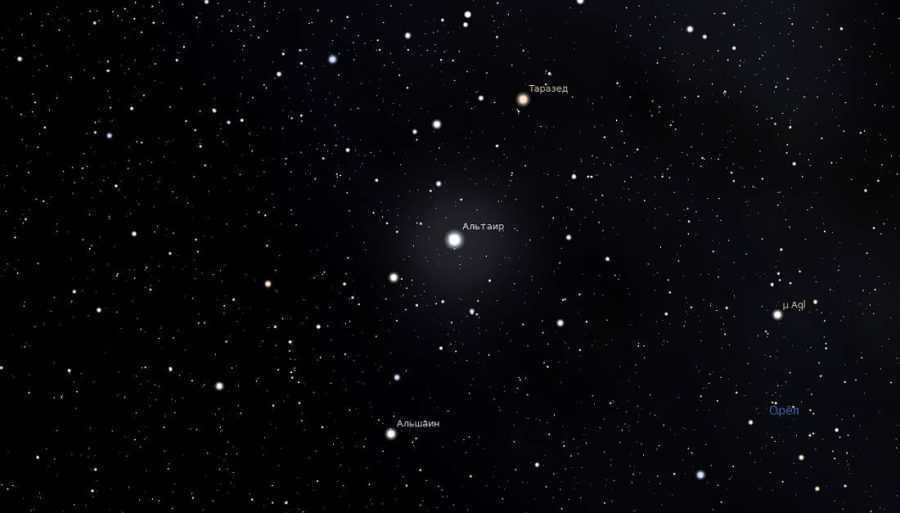
The Goddess of the Sky became enraged and decided to separate the couple by creating a tumultuous river. However, Hikiboshi and Orihime pleaded with her so fervently and with such tears that she couldn’t help but feel compassion. As a result, they were granted permission to reunite once a year, on the 7th day of the 7th month. This celestial event can still be witnessed today: Altair and Vega, symbolizing the two lovers, are separated by the beautiful expanse of the Milky Way.
Measurements of Altair have been conducted at the Palomar Observatory using a highly advanced interferometer. The star’s rapid rotation made it difficult for astronomers to capture its true form, but they were able to observe changes in its size, providing evidence of its non-spherical shape.
Altair is part of the “summer-autumn triangle” and serves as one of its vertices. It is also known as Alpha and, along with Gamma and Beta, forms a line known as the Val or Eagle Family.
Spectrally, Altair is classified as a type A star and remains on the main sequence. It has a significantly larger mass and radius compared to the Sun, with a diameter that varies by 22% between its equator and poles.
Studying Altair’s Characteristics
Findings from 1999 indicated that Altair’s brightness fluctuates within a range of 0.001 magnitude. In 2005, researchers determined that Altair is classified as a Beta Shield variable.
In a similar vein, during the 1960s, Robert Brown and his team measured the angular diameter of the star, which was 3 m/s. These scientists also postulated that Altair would contract due to its rotational speed, but due to inadequate equipment, the necessary evidence could not be gathered.
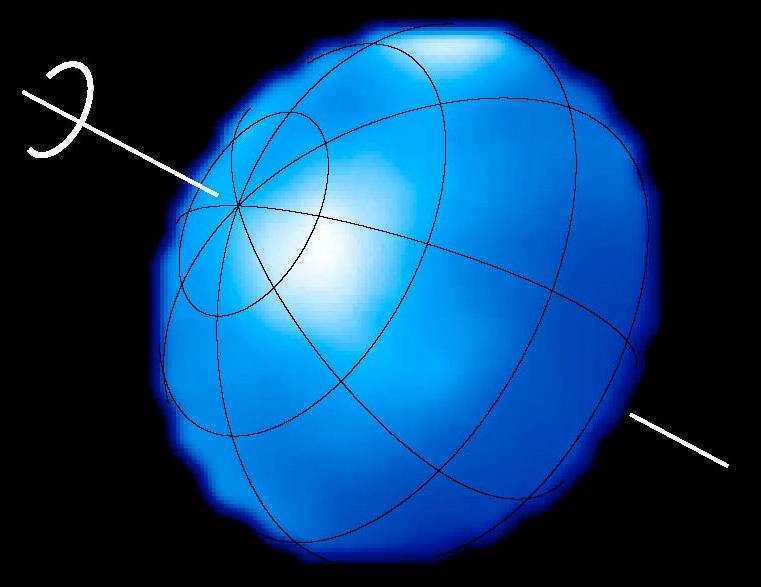

In the late 1990s and early 2000s, Gerard van Belle and his colleagues conducted a study on Altair and proposed that the star, due to its high rotational speed, exhibits lower gravity and temperature near its equator than previously believed. As a result, the brightness of its equator is diminished, a phenomenon known as gravitational darkening.
In 2005, Dominicano de Souza took on this research question and used the VINCI instruments on the VLT to measure the extent of gravitational darkening in Altair. Altair stands out as one of the few celestial bodies for which images of disks have been successfully captured. These images provide valuable insights into both surface compression and gravitational darkening effects.
The characteristics of the “flying eagle”
Altair is positioned in close proximity to Earth, approximately 16.8 light years away (which equates to a staggering 159 trillion kilometers), making it highly prominent in the night sky. It boasts a size twice that of the Sun, yet its radiation output is eight times more intense. Altair’s velocity of approach towards Earth is approximately 26 kilometers per second, and it will take approximately 12 thousand years for the star to traverse a single light year.
- Equatorial rotation speed: 286 kilometers per second;
- Time taken to complete one rotation: 8.9 hours (compared to the Sun’s 25 days);
- Age: 1000 million years;
- Diameter: 2370 million kilometers;
- Surface temperature: 7800°C, with a luminosity 11 times greater than that of the Sun;
- Apparent and absolute stellar magnitudes: 0.77 and 2.3, respectively;
- Spectral class: A7IV-V.
In order to thoroughly examine the surface of the 12th brightest star in the sky, a telescope with a mirror diameter of 300 meters is required. Currently, this specification is beyond our reach. However, astronomers have been able to observe the star using multiple telescopes.
Up to this point, no companion stars or planets have been discovered around Altair, but research is ongoing. Scientists speculate that it will remain on the main sequence for a considerable period of time. Once thermonuclear reactions involving hydrogen in the star’s core cease, the star’s body will gradually expand. There is a high probability that Altair will eventually evolve into a red giant.
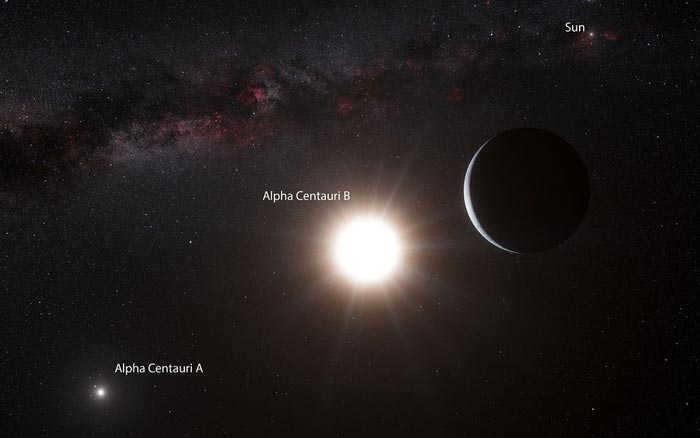
Alpha Centauri, the nearest star system to the Sun, is a captivating and luminous entity. Humanity holds onto the aspiration of encountering fellow human beings in that celestial realm. The components of the system are accessible for both scrutiny and examination.
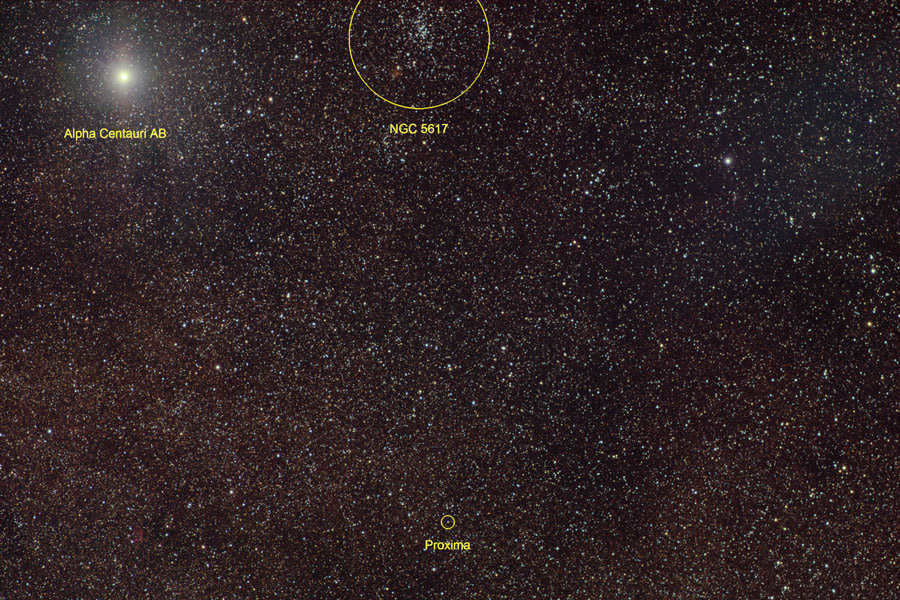
The NGC 5617 star cluster and the triple system.
Alpha Centauri, a triple star, is located in the Centaurus constellation in the Southern Hemisphere. To find this constellation, imagine a straight line connecting the Big Dipper and Virgo, then go 50 degrees south from the equator, and you will arrive at the desired location on the opposite side of the Earth.
This system consists of three components: the stars Centaurus A, Centaurus B, and the small red dwarf known as Alpha Centauri C or Proxima Centauri. It is a prominent feature in the night sky, ranking as the third brightest.

Alpha Centauri, which is located near Earth, is more than 2 billion years older than our Solar System. It has been around for 6 billion years, while the Sun, in comparison, is only 4.5 billion years old. Despite the age difference, the cosmic characteristics of these two celestial bodies are remarkably similar. In fact, they are so similar that they appear almost indistinguishable to the naked eye. However, with the help of a simple telescope, the small distance between them becomes clearly visible, revealing a captivating dance of two stars.
The light emitted by Alpha and Beta Centauri, the neighboring stars, takes approximately 4.3 years to reach Earth. These objects exhibit minimal fluctuations and are considered relatively stable. Both stars orbit around their own center of mass, which is also shared with a third celestial body.
Traveling to Alpha Centauri in a contemporary spacecraft requires a staggering 1.1 million years, making it highly unlikely to occur anytime soon.
Fascinating nearby celestial bodies
Alpha Centauri A
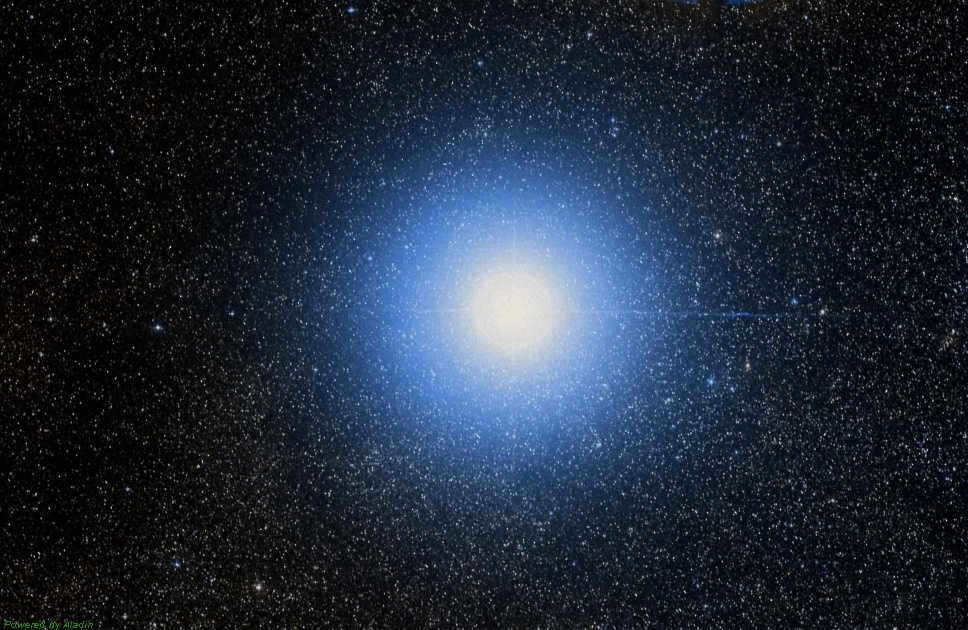
Centauri A, the initial star, bears a striking resemblance to the Sun. Its atmosphere contains a cold, thin layer. Alpha possesses a mass 0.08 times greater than that of the Sun and emits a brighter, hotter light. It is often criticized for outshining Beta Centauri, but due to their binary system, both stars can be seen in the sky.
Alpha is also known as Rigel Centaurus, referred to as “the foot of Centaurus” by the Greeks. This name was given to denote its position within the Centaurus constellation. Another less common name is Toliman, which is primarily used by astrologers. The star’s luminosity appears as white-yellow in color.
Alpha Centauri B
can be paraphrased as “The second star in the Alpha Centauri system.”
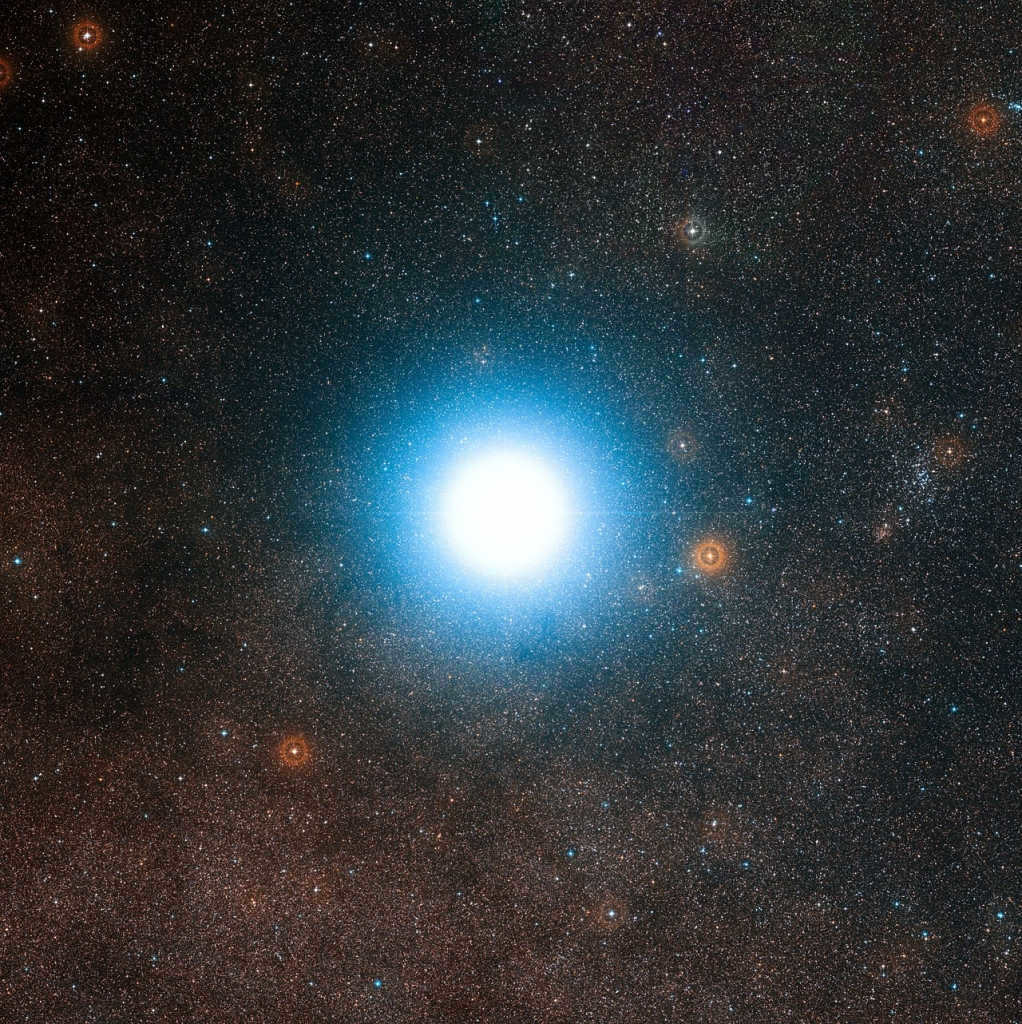
The second star, Centauri B, is 12% smaller than the Sun and therefore cooler. It is located 23 astronomical units away from Centauri A. These two stars have a strong gravitational pull on each other, which impacts the activities occurring on their surfaces and also affects the formation of planets. Centauri B undergoes rotation in relation to Centauri A, following an orbit that resembles a highly elongated ellipse. This rotation completes every 80 years, which is considered a rapid pace in the cosmic context.
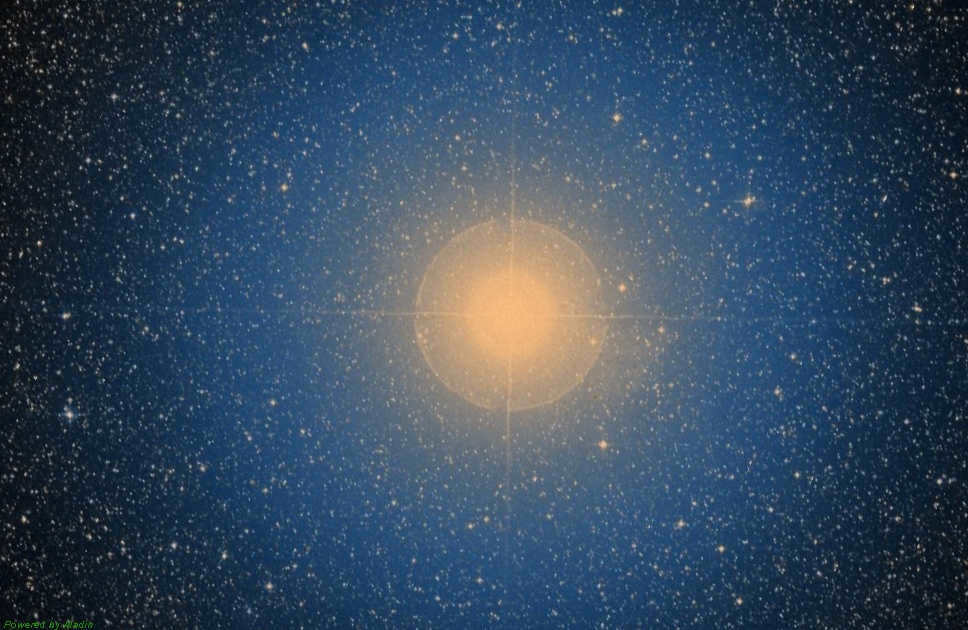
α Centauri B, as it is commonly referred to on star charts, is frequently associated with the Arabic term “Hadar,” meaning “bottom.” It is also sometimes denoted by its lesser-known name, Agena, which signifies its position within the Centauri constellation and translates to “knee.”
Proxima Centauri
Proxima Centauri is the closest known star to the Sun and is part of the Alpha Centauri star system. It is located approximately 4.24 light-years away from Earth. Proxima Centauri is a red dwarf star with a spectral type of M5.5V. It has a mass of about 0.12 times that of the Sun and a radius of about 14% of the Sun’s radius. Despite its small size, Proxima Centauri is still active and has been observed to have stellar flares. In 2016, an exoplanet named Proxima b was discovered orbiting Proxima Centauri, making it the closest known exoplanet to Earth.
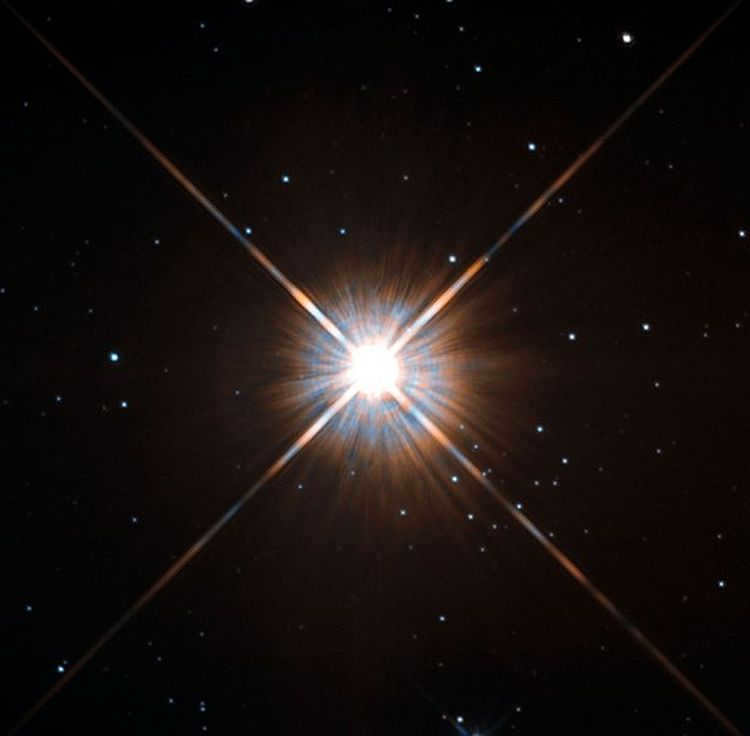
Resources related to the subject

The star’s designation is “closest”. It was given this name because, due to its orbit, it is the closest to Earth.
It is the third member of the system. It is an object with an eleventh stellar magnitude. Proxima orbits around two stars every 500,000 years. Some sources suggest that its rotational period can be up to one million years. Proxima has a very low temperature, which prevents nearby objects from heating up, so planets are not commonly found near it. This star is a red dwarf and occasionally produces highly intense flares.
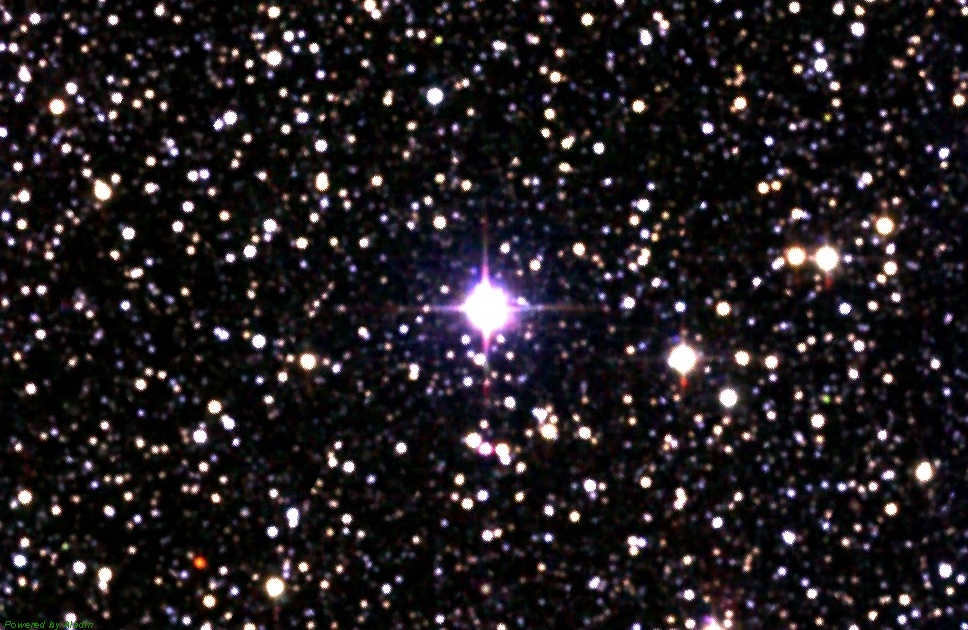
Proxima Centauri, an image from the 2MASS infrared sky survey.
Its temperature is six times higher than normal. Despite being much smaller than the Sun, it emits ten times more X-rays. The reason for this phenomenon is still unknown to scientists. There is still much to be discovered about this celestial object that falls in between brown dwarfs, planets, and stars.
Proxima is located 13,000 astronomical units away from its celestial family.
Where can you witness it?
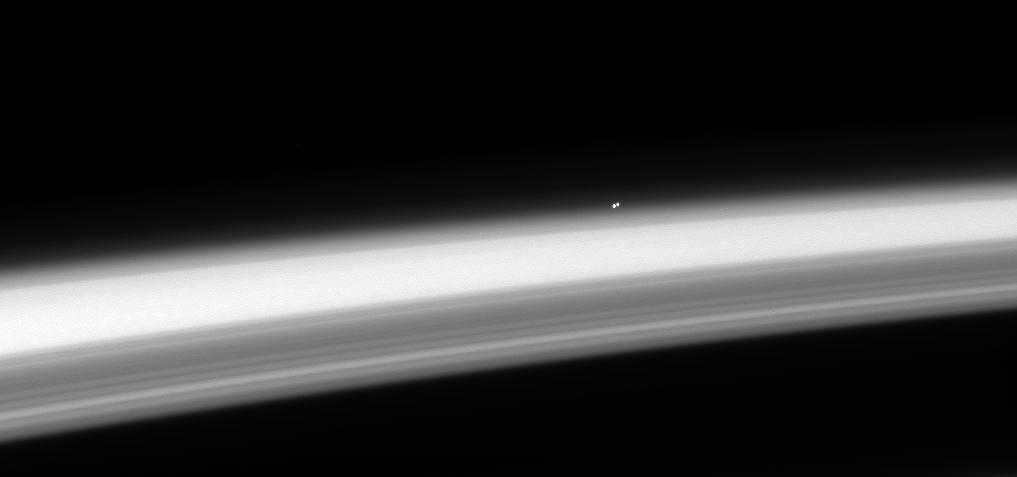

The image captured by the Cassini probe shows α Centauri A and B shining above the horizon of Saturn.
Astronomers in the Northern Hemisphere do not have the opportunity to observe Alpha Centauri as it is located in the southern sky. However, during the summer months, residents of Florida, Texas, and parts of Mexico can catch a glimpse of it just above the horizon.
Alpha Centauri holds significant importance in navigation. By drawing a line through Beta Centauri and intersecting it with a line from the Southern Cross, one can determine the direction towards the pole.
An Englishman named Henderson provided definitive confirmation 150 years ago that Alpha Centauri is closer than other stars. He conducted his study of Southern Hemisphere stars from the Cape of Good Hope. Henderson’s research aligned with the findings of Russian astronomer Struve V.Y. and German astronomer Bessel. As a result, the approximate distance to Alpha Centauri was determined and its proximity to our solar system was acknowledged.

The flag of South Australia, which was created in 1870, features the A and B Centauri stars at the bottom left and the Southern Cross constellation at the right.
In the 4th century BC, the ancient Greeks made a significant contribution to a star atlas by adding a bright dot. However, it was not until 1689 that the Frenchman Richaud separated the two stars and provided evidence of this phenomenon.
The discovery of the little red star Proxima occurred much later in 1915. This star, which is smaller than its companions, was identified by R. Innes, a Scottish astronomer.
The celestial bodies of the stellar system


An artist has created an image of the potential view from a planet that may exist.
In order to discover a planet that orbits a star, scientists dedicate years to measuring and studying its spectrum. The process of observing Beta Centauri, for example, took four years. In 2012, the scientists announced their discovery of a planet. This planet has a weight slightly greater than that of Earth and it orbits the star at a reasonable speed. It completes one revolution every 3,236 days, although it is too hot to support life. In terms of position, it can be compared to Mercury, which has been relocated ten times closer to the Sun. The planet rotates on its axis in 3.2 Earth days.

The Sun, as seen from Alpha Centauri
Alpha Centauri bears resemblance to our solar system in various aspects. Progress in technology will enable us to become better acquainted with our neighboring star system, and perhaps even pay it a visit. The distance from Alpha Centauri to the next star system spans multiple light years. It is no coincidence that Alpha Centauri has captured the attention of science fiction writers and screenwriters. It serves as the homeland to many extraterrestrial beings, houses space bases, and teems with vibrant life. A sense of kinship binds us together in the vast expanse of the cosmos.
Compilation of the most luminous celestial objects
| 0 | Sun | 0.0000158 | −26.72 | 4.8 | G2V | |
| 1 | Sirius (Alpha Canis Majoris) | 8.6 | −1.46 | 1.4 | A1Vm | Southern |
| 2 | Canopus (Alpha Carinae) | 310 | −0.72 | −5.53 | A9II | South |
| 3 | Toliman (Alpha Centauri) | 4.3 | −0.27 | 4.06 | G2V+K1V | South |
| 4 | Arcturus (Alpha Boötis) | 34 | −0.04 | −0.3 | K1.5IIIp | North |
| 5 | Vega (Alpha Lyrae) | 25 | 0.03 (permanent) | 0.6 | A0Va | North |
| 6 | Capella (Alpha Aurigae) | 41 | 0.08 | −0.5 | G6III + G2III | North |
| 7 | Rigel (Beta Orionis) | ~870 | 0.12 (permanent) | −7 | B8Iae | South |
| 8 | Procyon (Alpha Canis Minoris) | 11.4 | 0.38 | 2.6 | F5IV-V | North |
| 9 | Achernar (Alpha Eridani) | 69 | 0.46 | −1.3 | B3Vnp | South |
| 10 | Betelgeuse (Alpha Orionis) | ~530 | 0.50 (permanent) | −5.14 | M2Iab | North |
| 11 | Hadar (Beta Centauri) | ~400 | 0.61 (permanent) | −4.4 | B1III | South |
| 12 | Altair (Alpha Aquilae) | 16 | 0.77 | 2.3 | A7Vn | Northern |
| 13 | Acrux (Alpha Crucis) | ~330 | 0.79 | −4.6 | B0.5Iv + B1Vn | South |
| 14 | Aldebaran (Alpha Tauri) | 60 | 0.85 (removable) | −0.3 | K5III | North |
| 15 | Antares (Alpha Scorpii) | ~610 | 0.96 (permanent) | −5.2 | M1.5Iab | South |
| 16 | Spica (Alpha Virginis) | 250 | 0.98 (permanent) | −3.2 | B1V | Southern |
| 17 | Pollux (Beta Geminorum) | 40 | 1.14 | 0.7 | K0IIIb | Northern |
| 18 | Fomalhaut (Alpha Piscis Austrini) | 22 | 1.16 | 2.0 | A3Va | Southern |
| 19 | Mimosa (Beta Crucis) | ~290 | 1.25 (permanent) | −4.7 | B0.5III | Southern |
| 20 | Deneb (Alpha Cygni) | ~1550 | 1.25 | −7.2 | A2Ia | North |
| 21 | Regulus (Alpha Leonis) | 69 | 1.35 | −0.3 | B7Vn | Northern |
| 22 | Adhara (Epsilon Canis Majoris) | ~400 | 1.50 | −4.8 | B2II | South |
| 23 | Castor (Alpha Geminorum) | 49 | 1.57 | 0.5 | A1V + A2V | Northern |
| 24 | Gamma Crucis | 120 | 1.63 (permanent) | −1.2 | M3.5III | South |
| 25 | Shaula (Lambda Scorpii) | 330 | 1.63 (permanent) | −3.5 | B1.5IV | Southern |

